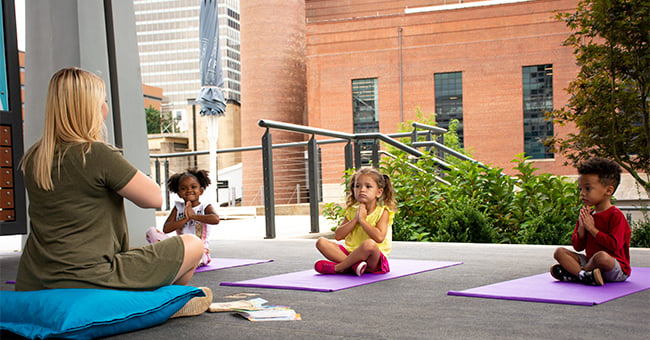
Heading back to the classroom may look a little different this year, but that doesn't mean it has to be stressful. Offering teachers peace of mind this back-to-school season, Dr. Elizabeth Erwin addresses mindfulness in the classroom by answering frequently asked questions based on her book The Power of Presence.
What is mindfulness?
Mindfulness is an ongoing practice of quieting the mind. This sense of inner peace is sustained by full awareness and simply being present in each moment without any narrative, judgment, or thought. Doing so gives the mind a break from our constantly-moving world, training us to quiet the mind and pause when we start to get wrapped up in busyness, stress, or anxiety. Mindfulness, or being present, fosters a commitment to well-being in body and mind, and enhances our ability to notice more clearly and reflect more deeply.
How can the practice of quieting the mind reduce stress for educators?
Through the practice of being present, we notice with a deeper sense of awareness what is happening in the moment, and this replaces the constant noise in our minds with a sense of calm and comfort. So, it's no surprise that practicing mindfulness reduces stress and burnout in teachers and enhances energy, focus, and resilience. When we pause, we notice the otherwise ignored signals our bodies are trying to send us about negative emotions and thoughts that need attending to (e.g., anxiety, stress, anger, impatience). By acknowledging these emotional triggers, we can seek a healthy outlet to maintain inner peace and restore a sense of ease instead of mindlessly reacting to them. And when educators are present with their students and finding joy in teaching, children feel safe, focused, and eager to learn.
How does mindfulness benefit young children?
Children learn best when they feel safe, comfortable, nurtured, and understood. Being mindful of each student reflects inclusive and equitable teaching which fosters deep respect between student, teacher, and the whole classroom community. Teach children that everyone is valuable by finding the genius within each child. Encourage children to think deeply and critically, in ways that matter and are meaningful for them.
Young children observe and adopt the patterns from the adults in their lives. This means if you avoid hurry and the pressures it brings, they will too. Slowing down and being present in the moment prevents children from learning to navigate the world through a lens of worry and pressure.
Engage with children in a steady mindfulness practice! Consistent practice benefits children by enhancing their focus, attention, self-regulation, and physical and social-emotional growth. And when they become more aware of their own emotions, they become more aware of others' too. Practicing presence in the classroom is a great way to maintain an inclusive classroom community where each child feels comfortable, confident, and valued.
What are some practical ways to create a climate of mindfulness in the classroom?
Once you have established your own mindfulness practice, teach students how to be mindful with you. There are many ways to integrate mindfulness into your classroom, but here are just a few:
- Take responsibility for your mind: Be conscious and reflective of what you think, and encourage children to do the same. Thoughts and beliefs affect our posture toward others and eliminating negative ones is a step toward respect and justice.
- Establish a Mindful Minute: Build into daily routines a time to pause for a minute of silence and stillness, keeping eyes closed and focusing on slow, peaceful breaths. Controlled breathing is directly connected to emotional regulation and stress reduction.
- Go for silent walks: Walking outside can deepen our connection with nature and promote inner peace and a sense of calm.
- Create spaces for silence: Whether it be a silent activity table, a cozy corner, or peaceful carpet squares for silence, provide space for children to be quiet, reflective and regulate their emotions. Try adding "peace cushions" to your classroom that children can sit on or hold when they feel angry, anxious, impatient, or if they simply want to experience a deeper sense of peace during the day.
- Foster the home-school connection: Ask families what makes their child feel safe, calm, and engaged to bring consistency to their mindfulness practice.
- Practice listening: Tune into your intuition and allow children to follow their own.
- Learn from your students! Children are naturally curious, mindful, and joyful. Listen to them when they share their ideas, reflections, and experiences about mindfulness.
About the Author
Elizabeth Joy Erwin, EdD is Professor of Education at Montclair State University where she prepares master's and doctoral students to think critically, reflect deeply, and teach inclusively. Over the past 30 years, Dr. Erwin's commitment to educational equity in early childhood has been at the heart of her teaching, advocacy, and research. Within the primary theme of challenging injustice (with an emphasis on disability), Dr. Erwin's scholarship focuses on inclusive education. In pursuit of social action, both locally and globally, Dr. Erwin has published widely in prestigious academic journals and has authored multiple books and chapters including The Power of Presence: A Guide to Mindfulness Practices in Early Childhood. She has accepted invitations to teach about inclusive early childhood worldwide, for example in Kazakhstan, Mongolia, Slovakia, and Ukraine. She has engaged in educational inquiry and collaborative projects with universities around the world. Dr. Erwin currently lives in New York City, where she practices yoga and meditation every day.
